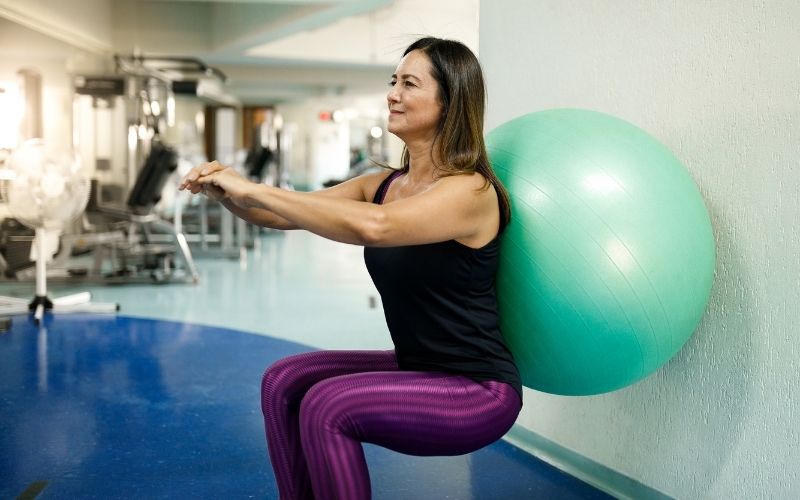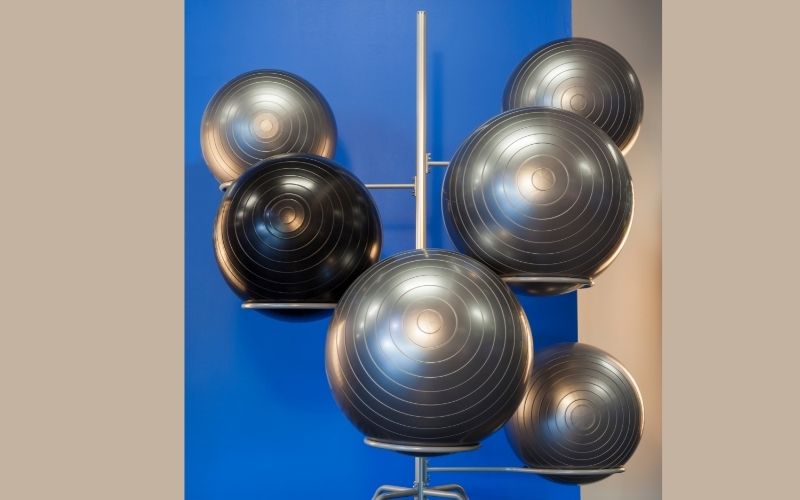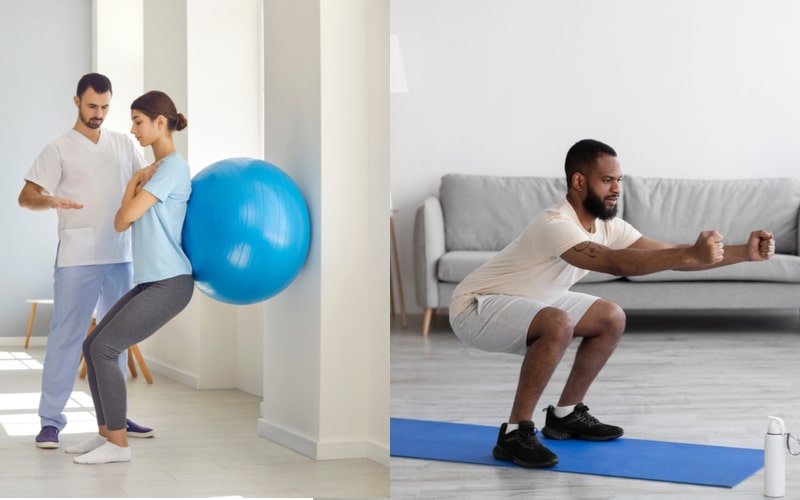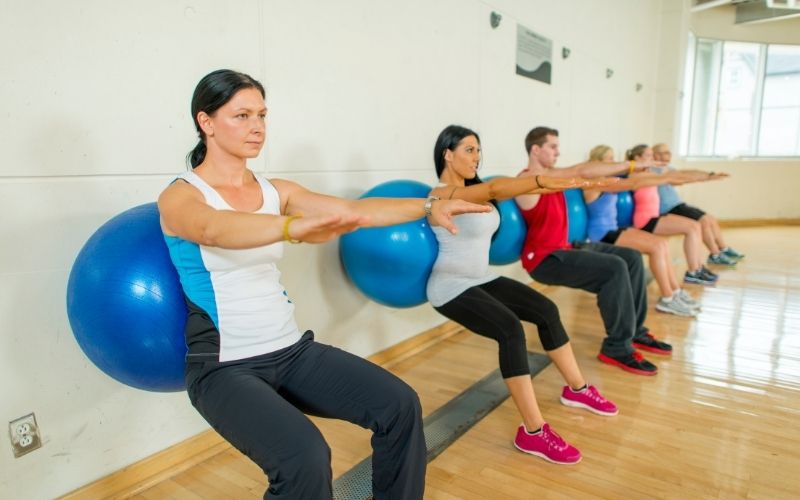Being creative when working out is one of the most effective ways to keep your workouts motivating and challenging. Using different exercise techniques and tools makes your workouts more exciting and can also help target specific body parts.
One such tool for making your workouts dynamic is an exercise ball. These inflatable balls are highly versatile exercise tools that can help you take regular exercises to the next level.
Wall squats are deceptively easy but are a great way to target your glutes, quads, and calves. Depending on your height, you can either get a 55 cm, 65 cm, or 75 cm exercise ball and turn your traditional squats into a more enjoyable and challenging exercise.
Here’s everything you need to know about getting the right size exercise ball to improve your wall squats.
Table of Contents
Are Exercise Ball Wall Squats Effective?
Yes, wall squats are a great exercise to strengthen your muscles and increase your flexibility. It helps strengthen your lower body by targeting your quadriceps muscles, one of the largest muscles of your body, and your hamstrings and glutes.

Add in an exercise ball into the mix, and you will be able to make the most of extending your legs and flexing your thighs, and working various lower body muscles. An exercise ball will also help you develop better balance and posture.
Exercise ball wall squat is one of the most effective cardiorespiratory fitness workouts as it increases your heart rate and helps burn calories. It also enhances your explosive power, essential in many athletic activities.
If you lack stamina, doing well-executed exercise ball wall squats can help you climb stairs without going out of breath and rise from your chair without any discomfort. Those suffering from “runner’s knee” or patellofemoral pain syndrome are also advised to alternate regular squats with exercise ball wall squats to boost endurance.
How Do You Choose the Right Exercise Ball Size for Wall Squats?
Ready to incorporate the exercise ball in your workouts? Your next question probably is, what size exercise ball for wall squats? You can’t pick up any ball you see from Walmart or a fitness equipment store.
When shopping for an exercise ball for wall squats, you should ideally sit on the ball and check whether your knees and hips form a 90-degree angle and are parallel to the ground.

There are different exercise ball sizes available in the market, and you and your alignment with the ball make all the difference in identifying which one is best suited for you.
Exercise balls are available in industry-standard sizes of 55 centimeters, 65 centimeters, and 75 centimeters. When fully inflated, these sizes refer to the exercise ball’s diameter or height . These measurements are designed to get the ideal ergonomics and body alignment.
Here are the ball sizes for different heights for your reference:
- Height between 5’0″ and 5’5″: A small exercise ball with a diameter of 55 cm or 22 inches.
- Height between 5’6″ and 5’11”: A medium exercise ball with a diameter of 65 cm or 26 inches.
- Height between 6’0″ and 6’3″: A large exercise ball with a diameter of 75 cm or 30 inches.
There are also fitness shops that offer smaller sizes from 45 cm (18 inches) to 55 cm (22 inches), ideal if your height is below 5’0”.
This sizing serves as a guide. You can use different sizes of exercise balls for different workouts. For example, a smaller exercise ball makes an excellent ab exercise tool, while bigger ones are great for bench workouts.
How to Do Wall Squats with an Exercise Ball?
Here’s a simple guide for doing an exercise ball wall squat:
- Stand with your feet hip-width away from each other.
- Put the exercise ball in between the wall and your lower back.
- Settle your hands on your hips and lean against the ball.
- Bend your knees and lower your body. Do this gently and gradually until your thighs are parallel with the floor.
- Allow the exercise ball to roll down your back slightly.
- Hold for a count of five and push into your heels to return to your primary position.
For beginners, get into the squat position gradually and get comfortable with this stance before trying to bend your knees all the way.
It is also recommended that you lower your hips towards the floor, a little at a time, until you know that you can hold the position confidently.
Here are some tips you can follow to ensure that you are doing the exercise ball wall squats correctly. This can make your form better and your workout more effective.
- The exercise ball and your lower back should always be in contact. There should always be a portion of the ball that’s always connected to your back.
- Always keep your eyes forward and your weight against the exercise ball.
- Press against the exercise ball when you push into your heels to get back to the original position. This will give you more stability.
- Keep your feet facing forward when doing the exercise ball wall squats.
- Don’t allow your knees to roll to your sides. They need to be in line with your body.
- Adapt the “slowly but surely” method, meaning you don’t have to be doing full squats just yet. You can spend time just keeping your back in contact with the ball and moving forward while ensuring your technique and form are correct. Take it slow.
This video presents an informative guide to doing wall squats with an exercise ball. You can also check that you have the proper form with this Scott Malin video above.
Exercise Ball Wall Squat vs. Normal Squat: Which is Better?
Choosing between traditional squats and exercise ball wall squats is entirely up to you. Both are effective exercises that target specific parts of your body.
Performing exercise ball wall squat minimizes the impact on your glutes and hamstring but has a noticeable quadriceps involvement. This exercise is more focused on your knees than the standard squats. But if you have weak knees, then regular squats would be a safer option.
On the other hand, regular squats are best after strengthening your legs, specifically your glutes, hamstrings, and quads. They are considered the “king of leg exercises.” Regular squats are also effective in toning and strengthening your leg muscles, abdomen, and lower back.
However, you may not be able to do regular squats after an injury as this exercise can be rather stressful to the body. This is where incorporating the exercise ball comes in handy.

Both regular squats and exercise ball wall squats have different focus areas and levels of difficulty, so one can’t say which one is better. It all depends on your fitness journey and goal.
Conclusion
An exercise ball is a fantastic addition for any fitness enthusiast. Unlike most gym equipment that can be intimidating, this bouncy vinyl ball adds a little fun to your workouts.
Knowing and choosing the right exercise ball size is fundamental to performing various exercises, including wall squats. Hopefully, this guide can help you make the right choice for your needs.

My name is Vance, and I am the owner of To Ergonomics. Our mission is to improve your workflow by helping you create a supportive and welcoming environment. We hope that you’ll find what you’re looking for while you’re here.

